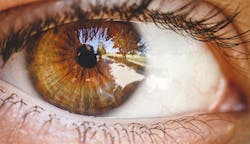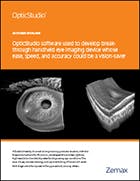What We Can Learn From The Human Eye, A Mediocre Optical System With Exceptional Onboard Software
Depending on the device, good image processing software can greatly reduce the need for accurate optical systems. One example of this is the human eye, which is a weak optical system, but can see very well because of the human brain’s image processing ability. This “onboard software” in the brain is exceptional: A team of MIT neuroscientists found that the human brain can process images that the eye sees for as little as 13 milliseconds—far faster than the 100 milliseconds suggested previously.
Here are three things learned from the human eye that we can apply to optical product design:
- Onboard software can compensate for an imperfect optical system
Just as our brain can process images quickly even if our eyesight isn’t perfect, onboard software can compensate for imperfect optical performance. Cheaper lenses may be used, and the software will help overcome any shortcomings due to things like distortion, relative illumination, and chromatic aberration in order to correct the system. This is important in scenarios such as factory automation. When a machine vision camera captures an image, it is much easier to make image analysis (inspection), if the captured image is a high-quality image, but if it’s not, processing can be used to optimize the image prior to making a pass/fail decision. - Image processing software can impact optical design requirements
Vignetting has traditionally been used to produce higher resolution at the expense of uniform illumination. But with digital image processing, there is less of a requirement for uniform illumination, which in turn allows for more vignetting and smaller lenses. Digital processing may also reduce requirements for color and distortion correction as these defects can be removed post detection. In short, onboard software may continue to change what’s most important to optical engineers during the optical design process. - Onboard software can free up designers to focus on other aspects of the optical system
Since our brain is handling imaging processing, our eyes are free to keep moving and seeing the world around us. Similarly, in an optical system with onboard software like many modern cell phones and digital cameras, since distortion is usually resolved by software, the optical designer has more time to focus on improving the other parts of the optical system. For example, the optical engineer can make improvements on third order aberrations such as astigmatism or coma.
Focusing on the entire system
Though onboard image processing software has certain benefits, it should not be used as a safety net to “fix” a faulty optical system. Instead, optical designers need to take the entire system into account during the design process: source, optics, detector, mechanics, electronic controls, software/post-processing, and environment. Thinking about the entire system, including software and post-processing, allows engineers to design the best, most cost-effective product in the most efficient way possible.
More learning from the human eye: Modeling this imperfect system
Optical models of the eye are used to design instruments to look into the eye (for example to check the uniformity of illumination of a fundus camera), to design instruments that the eye looks through (including some properties of ophthalmic lenses, contact lenses, and intraocular lenses), and to investigate the optical system of the eye itself (including the effects on retinal image formation of eye pathology such as corneal scarring and cataracts).
There have been literally dozens of eye models published over more than 150 years, from very simple “reduced” eyes consisting of a single refracting surface to very complex models with more than 4,000 refracting surfaces. Some models have a gradient index crystalline lens, some represent the gradient index with two or more homogeneous shells, and some have a homogeneous lens. There is no ideal optical model of the eye that is best for every purpose, and a more complex model does not necessarily represent all eyes, or any particular eye, more accurately. Zemaxprovides several sequential and non-sequential models of the human eye in OpticStudio, with glass catalog data, so engineers can design a model of this imperfect system to learn how to design more perfect optical products in the future.
Case study: OpticStudio used to develop break-through handheld eye imaging device
A Duke University biomedical engineering graduate student with the Fitzpatrick Institute for Photonics used OpticStudio to develop the smallest, lightest, high-resolution handheld probe for diagnosing eye conditions.


